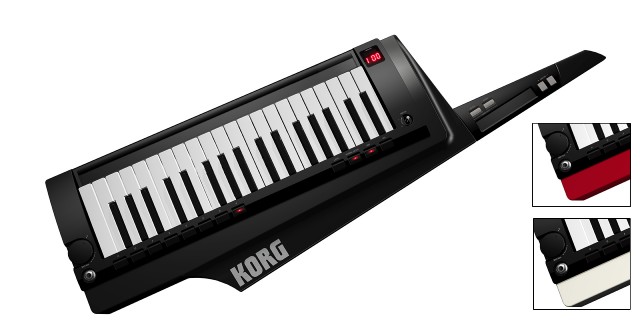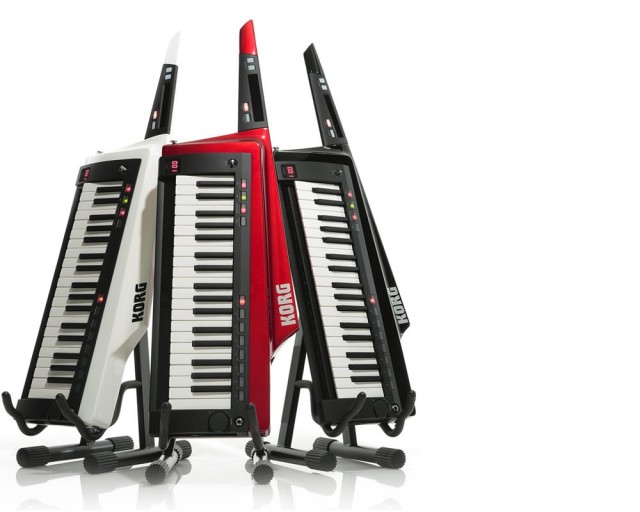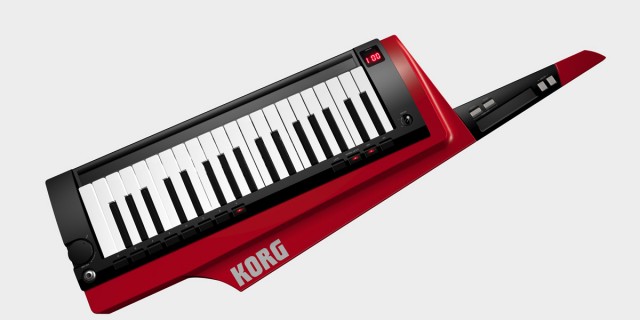Korg’s RK-100 turns 30 this year, marking a milestone for one of the first keytars. (KORG is using the term “keytar,” not the less-pleasant-sounding “strap-on,” and who am I to argue?)
It’s easy to forget that part of the reason that keytars made an appearance briefly in the mid-1980s was that the role of the synthesist had changed. This was not simply a ploy for keyboardists to prance about onstage. The rise of electro and synth pop meant that the keyboardists themselves had found a more central role in the music and sound, a lead, front-of-stage part in the band rather than as a rhythm section.
Then again, not everyone is Rick Wakeman, and old habits die hard — guitars are things worn on shoulders; pianos are not things worn on shoulders, apart from accordions, which have image problems of their own. The music descended into camp; the keytar descended into camp. And after the understated Roland SH-101, which added a tiny arm to an otherwise conventional keyboard, KORG, Yamaha, Casio, and later Roland went for splashier designs that probably should be left in the 80s.
Not that keytar advocates have given up. Roland’s AX- line was a hit. Herbie Hancock plays one. (Those four words balance out anything anyone else might say about the keytar.) When the AX-7 was discontinued, fans clamored to bring it back – and Roland responded. Alesis launched the Vortex, a more affordable alternative that adds drum pads; this year, it went wireless.
In celebrating their keytar’s thirtieth birthday, though, KORG has gone further. The new RK-100S is a “reimagining” of the original, not a remake – the polar opposite of last year’s MS-20 mini reissue. And that’s a good thing, too. The MS-20 synth holds up to modern demands in sound and connectivity; add MIDI, and it’s basically timeless. An original RK-100 is not something you’d want: it’s chunky, cheap, has no internal sounds, and lacks velocity sensitivity or useful controls beyond mod.
The RK-100S promises to be sexy new Battlestar Galactica to old Battlestar Galactica – Tricia Helfer and James Callis in place of a shiny tin can. (“Reimagined.”)
RK-100S – New Body, New Brains
Body. The first thing you need to know about the RK-100S is wood.
Yes, finally learning something from those guitar players and other instrumentalists, the RK-100S has a solid wood body. But wood is a wonderful material, both sturdy and light. Even with six AA batteries loaded, the total weight is still 3.4 kg (seven and a half pounds).
So, with choices of red, white, and serious-looking black, the RK-100S doesn’t look ridiculous. A 37-key keyboard will still look large on most people – this one is slim, but long, at 830 x 262 x 71 mm/32.68 x 10.32 x 2.80 inches. But the RK may be the best-looking keytar ever. And it’s mobile: it’ll run about four hours, KORG says, on those AA’s. (It’s a shame they don’t have a higher-capacity battery, though, especially as there’s room.)
Intelligently, at least, the RK trims down the way the MS-20 mini did – it shares the same mini keybed.
Ribbons and controls. Possibly the most sensible decision on the RK is finally getting the control complement right. There’s a short ribbon on the neck, plus – in a first for any major-manufacturer keytar – a long ribbon along the keys. This actually lets you be a little bit more like Rick Wakeman, since you can use the keys for discrete pitches and the ribbon for sweeping, long, continuous pitches. You can switch between “pitch” and “filter” (though not mod?!) on the neck. It’d be nice to see an additional mod control – the other controls you see are volume, pitch selection, and switches. But the ribbon probably makes up for that.
Sound. KORG’s MMT (Multiple Modeling Technology) is onboard, providing a set of microKORG XL+ sounds from the same engine. It’s two-part multi-timbral with Layer, Split, or Multi, and you can use 8 voices at once (4 voices with the vocoder) – probably all you’d really want on a keytar.
MMT uses different modeling techniques, as the name implies. It’s real Virtual Analog, and the microKORG XL+ sounds really good (even if some of us favored the raunchier, lo-fi sounds of the original microKORG). And you therefore get a pretty flexible synthesis engine, heftier than what Roland’s AX-Synth provided when it was introduced five years ago.
Oscillator 1 can be driven by ana analog in, by PCM/DWGS playback, or modeled saw, pulse, tri, sine, formant, and noise. (Oscillator 2 has just the modeled waves.)
There’s waveform modulation, cross-modulation, unison, ring, sync, KORG’s VPM (frequency modulation) and combinations thereof. And thanks to MMT, you get wave shaping (DRIVE, DECIMATOR, HARDCLIP, OCT SAW, MULTI TRI, MULTI SIN, SUB OSC SAW, SUB OSC SQU, SUB OSC TRI, SUB OSC SIN, LEVEL BOOST), plus two selectable multi-mode filters.
There’s also an EQ and 17 master effects.
You get 200 programs based on this engine, though it appears, sadly, you can’t program your own – too bad with that engine inside. (I’m looking into that.)
And because everyone needs a vocoder…
Extras. KORG has added a 16-band vocoder with formant shift and formant hold. This will separate the electro men from the boys / women from the girls, if you can pull this off without looking ridiculous. Ahem. The sound should be familiar, though; again, it’s the microKORG XL+ engine.
There’s a mono mini jack which you could use for the mic or more creative uses.
Critical on a keytar, there’s also a basic arpeggiator, with step function, up, down, random, and other patterns.
There’s also MIDI out and USB, so you can still use this as a controller, as on the original.
Pricing / Availability
Keep in mind that lovely wooden body, and let’s talk price.
US pricing hasn’t been set yet, but in Europe, £695 UK / 832€ pricing is set. That almost certainly includes VAT, though, so I would guess the US should be well under $1000. (My guess, not KORG’s.)
You just have to want a keytar. A microKORG XL+ costs you a fraction of that. On the other hand, this is a lot prettier, and potentially a lot more playable if you can adapt to keytar technique.
Comes with a case. Does not come with roller skates.
http://www.korg.com/us/products/synthesizers/rk_100s/index.php




